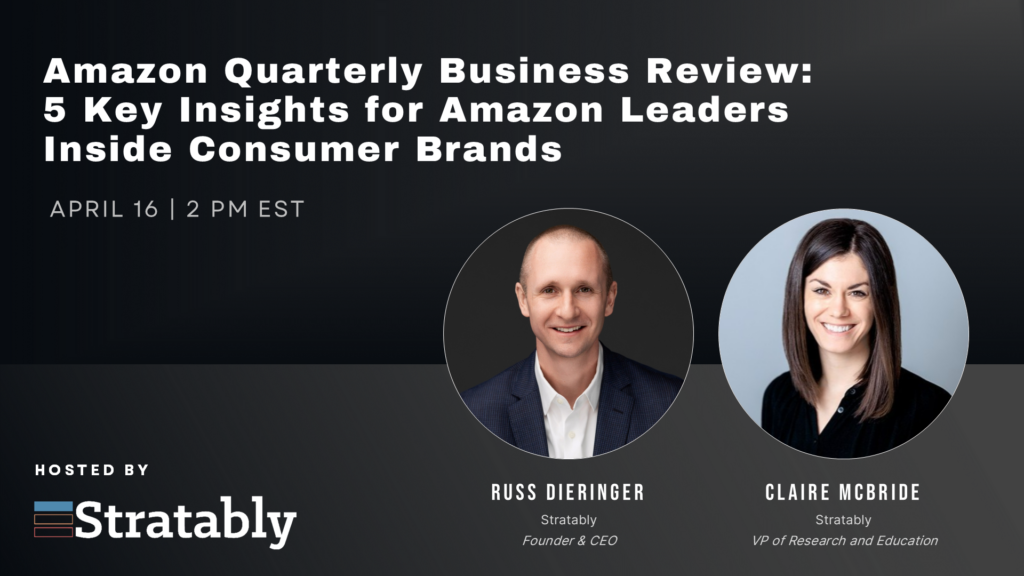January 24, 2023 @ 2pm EST
Many brands struggle to get the desired performance out of their Walmart Sponsored Products campaign.
Join Russ Dieringer and Stu Clay to walk through the reasons why this occurs, and importantly, how to fix it.
The presentation will include a quick overview of Walmart Sponsored Products ad units and then an auditing deep dive:
- Operational review (assortment, BB%, pricing, listing quality, etc…)
- Campaign & ad group audit (structure, multipliers, product/keyword amounts, etc.)
- Product & keyword review (bids, match types, optimizations)
- Leveraging data and reporting to guide strategy (Reporting for products, keywords, placements, platforms)
- Accelerators (Sponsored Brands, Display, Social, etc…)
This session is designed for intermediate to advanced eCommerce practioners that are currently advertising on Walmart.
Presenter: Stu Clay, Director of Marketplace Strategic Services, Walmart.
All Signal, No Noise Format:
- 15 minutes of prepared remarks
- 10 minutes of Q&A
Want to learn more about this session?
Read our interview with Stu where he elaborates on this session...
Give us a sense of the type of work you do with Walmart in your role at Tinuiti?
My role as the Director of Marketplace Strategic Services at Tinuiti revolves around identifying and establishing new and emerging Retail Media opportunities.
Although my role interacts with many different Retail Media channels including Target, Instacart, and Kroger (just to name a few), my main focus is set on strengthening our holistic relationship with Walmart and ensuring advancement within Product, Partnership & Performance.
Why did you want to present on this topic? Why should consumer brands attend?
It will help brands improve their advertising performance on Walmart.
When working with sellers of all shapes and sizes, a common theme that I run into is that brands have a lack of understanding as to the performance expectations and nuances of Walmart’s Sponsored Products offering (recent second-price auction transition, self-competition, no negative keywords, and more).
Additionally, many brands have the inaccurate perception that their Amazon strategy and corresponding performance expectations will be the same on Walmart. Walmart is a unique marketplace with a unique advertising value proposition. As such, efforts and expectations should be treated that way.
This session will give brands a better understanding of Walmart Sponsored Products’ operational nuances and performance expectations so that they can appropriately position strategy to get the most out of their ad dollars in 2023.
Who do you think will get the most out of your session?
Brands that are struggling to perform will get the most out of this session.
I’ll perform a deep dive into Sponsored Products campaign setup and ongoing audit focus areas to ensure that they know the first places to look when attempting to improve performance on Walmart.
What's one takeaway you want to be sure your attendees leave with after your session?
I want the attendees to understand the clear, tactical steps needed to take when trying to improve Sponsored Product performance on Walmart.
What are some of the common challenges that arise when brands go to put money to work in Walmart Sponsored Products?
Some common challenges I see when brands approach Walmart advertising include:
- Item Setup/Operations having a negative impact on ad efforts
- Team segmentation and lack of understanding of retailer/brand relationships outside of advertising (JBPs/Commitments, Buyer relationships, Promotions)
- A lack of understanding of Walmart’s ad policies and nuances (self-competition, no negative keywords, high in-store cash rate (untraceable))
Should brands expect the same performance between Walmart Sponsored Products and Amazon Sponsored Products? Why or why not?
The short answer is “no.” The long answer is “it depends.”
As mentioned, Walmart and Amazon are two very different platforms with very different performance exactions, ad offerings and overall experiences. The way that a brand performs on each platform will be dependent on their category, competition, assortment, reach and numerous other factors that can have a direct impact on performance.
For example, with an everyday staple like milk, performance expectations on Walmart will be dramatically different given Walmart’s grocery dominance and their ability to leverage 4,500+ physical stores. Whereas milk on Amazon Fresh would perform quite differently given the fact that it will be primarily delivery driven and have limited geographic availability due to Amazon’s lack of physical locations.
Category aside, each platform has different optimization levers, different algorithms and vastly different access to reporting/data. Pair that with the obvious difference in eCommerce demand signals and growth trajectories, and you have yourself two very different ad opportunities with vastly different value props and expectations.



